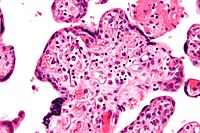
Photo from wikipedia
BACKGROUND Foetal growth patterns and birth weight (BW) have been associated with bone mineral density (BMD) and content (BMC) throughout infancy and childhood up to early adulthood. We hypothesized that… Click to show full abstract
BACKGROUND Foetal growth patterns and birth weight (BW) have been associated with bone mineral density (BMD) and content (BMC) throughout infancy and childhood up to early adulthood. We hypothesized that in small for gestational age (SGA) children, compensatory infant catch-up growth to normal height centiles counteracts the adverse consequences of low BW on bone accrual. AIM To evaluate BMD and BMC of SGA children born at term who experienced a normal catch-up growth as compared to children born appropriate for gestational age (AGA). PATIENTS We recruited 53 SGA (26 females) and 60 AGA children (27 females), aged 6 to 18 years, matched for sex and body mass index (BMI) . Fat mass (FM); Free fat mass (FFM); Lumbar spine and Total body less head (TBLH) BMD; BMC and BMD standard deviation scores corrected for body size (BMAD, BMAD z-score and TBLH BMD/Height) and TBLH BMC for FFM (TBLHBMC/FFM) were derived from Dual Energy X-ray absorptiometry (DXA) scans. RESULTS SGA and AGA children did not differ in any auxological, body composition and bone parameters appropriately adjusted for height and FFM. BMI, FM and, remarkably, FFM were significantly correlated with bone mass parameters in both groups while no correlation was found between FM and FFM with the BW SDS in the univariate analysis. CONCLUSION Our preliminary data demonstrate that SGA children born at term who recover from their growth deficiency through catch-up growth achieve bone mass and body composition not different from children born AGA.
Journal Title: Bone
Year Published: 2021
Link to full text (if available)
Share on Social Media: Sign Up to like & get
recommendations!